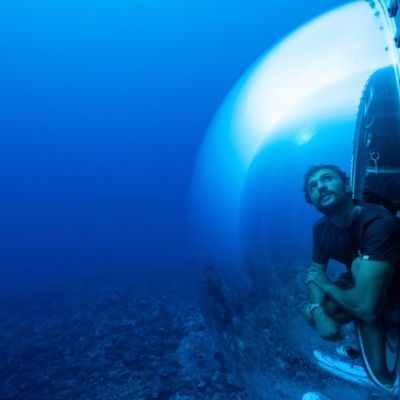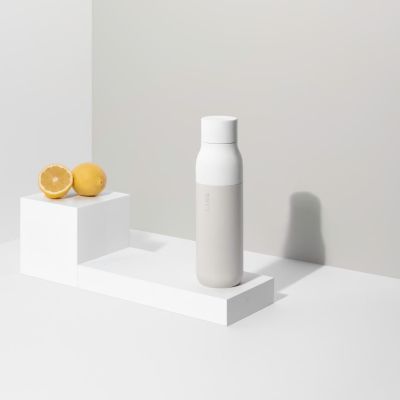The Mushroom That 'Eats' Plastic

Scientists at Kew Gardens are harnessing plant life to solve man-made problems such as plastic pollution.

A mixture of wild, floral abandon and world-class scientific endeavour, London’s Kew Gardens are filled with Victorian glasshouses, esteemed research laboratories and trees from Madagascar, China and Peru. All around them are very English banks of foxgloves, walled gardens covered in roses, and tree-lined pathways leading to woods drunk on wild violets.
Sir David Attenborough, a long-time nearby resident, has described Kew as his favourite place in London. “I first came here when it cost a penny and the public were let in almost under sufferance,” he told the BBC Today programme. “When I had an office job with the BBC, I used to come down at weekends when I was feeling really depressed and take a deep breath because there was the smell of the tropics here.
“It’s breathtakingly beautiful and the most important botanic institution in the world. Kew does a lot of things nothing else can do — if you want to identify something, this is the ultimate authority. Plant species can go extinct just like animal species, and it’s here that they identify possible problems and diseases.”
Kew’s global status rests on this unusual dichotomy. These gardens achieve the almost unique mix of feeling wonderfully romantic while being an international leader in modern botany. Which explains why, on a bright Tuesday afternoon, I found myself discussing plastic-eating fungi rather than Instagramming the roses.
Thanks to one of the world’s leading teams of botanists, scientists and conservationists, Kew Gardens is shaping the way we relate to nature. Instead of seeing plant life as passively beautiful, these scientists are trying to harness it and use it as a tool to solve man-made problems.
Dr Ilia Leitch, an expert in plant and fungal biology, took me around her labyrinth of rooms. One of them contains a series of ordinary-looking fridges, with each holding the DNA for more plants than exist in the Amazon basin. She hopes to have documented every botanical in the world in the next 20 years and placed it in her icy library.

“We gathered DNA for all the plants in easy places such as Europe first; it is getting hold of the ones that grow in hard-to-reach places thousands of miles away from Kew that is the difficult part,” she says, with an undeniable look of relish.
Another room is covered in test-tube bottles of fungi, one of which recently hit the headlines for being a potential miracle cure for humanity’s attachment to plastic. “Ah, the brilliant fungus,” Leitch said, with almost motherly pride, as she showed me a test tube filled with yellow liquid and black spots. “Now this one could really shake things up.”
Found last year by a team of Chinese scientists on a rubbish dump in Pakistan, Aspergillus tubingensis — the dazzling fungus in question — breaks down bonds between plastic molecules, splits them using its mycelia and consumes the debris. The process takes a matter of weeks, rather than the decades usually required for plastic to naturally disintegrate.
“This is incredibly exciting because plastic is such a big environmental challenge,” says Leitch. “If this can be the solution to a problem the world doesn’t know how to fix — a problem that is destroying our oceans — then that would be absolutely wonderful. We are in the early days of research, but I hope to see the real, tangible benefits of fungi that can consume plastic in five to 10 years.”
In the meantime, Leitch is hoping to rebrand fungi’s not particularly sexy image, reminding me more than once that its existence is essential to our daily lives, providing the basis for everything from beer and cheese to penicillin and washing powder.
“The most famous type of fungi — mushrooms — is consumed the world over,” says Leitch. “But fungi is so much more than that. It’s essential to our existence, considering that we would be covered in litter and dead matter if it weren’t for fungi. There is still so much more to know about it. We want to know what ecosystems there are, what is under threat and what each enzyme can actually do.”
Kew’s Fungarium is the largest in the world, and home to more than 1.25 million dried fungal specimens, each one filled with untested enzymes that could change the way we live. In the last year the researchers at Kew have found 2,189 new species of fungi, while an estimated 2.2 million to 3.8 million species are yet to be analysed.
“It has been a real eye-opener drilling into the data on the fungal kingdom,” says Kathy Willis, director of science at Kew. “Their ability to play both Dr Jekyll and Mr Hyde roles within their environments is unparalleled. For example, the fungal kingdom includes yeast, which has been used for over 9,000 years to ferment food and drink, but also includes some of the most economically damaging pathogens threatening food security and natural ecosystems.”
After I said goodbye to Leitch and her planet-saving test tubes, I walked up to the breathtakingly beautiful Temperate House, which emerged from a £41 million five-year refurbishment last summer. Designed by Decimus Burton in 1860, it is the size of three Boeing 747s and has been the largest glasshouse in the world since its construction.
Several of the plants inside are part of international conservation projects. One is the South African cycad Encephalartos woodii, also known as the “loneliest tree in the world”. A survivor from the time of the dinosaurs, it is now extinct in the wild, and only this male specimen — a clone of the tree that arrived at Kew in 1899 — remains. Unless a female is found, it will never reproduce naturally.
Much like the Victorians who came before me, I touched the spiky leaves of endangered plants born in far hotter climes than this one. There was the Dombeya mauritiana, a tree that was thought to be extinct before one was found in the highlands of Mauritius in the 1980s, and the Nepalese Taxus wallichiana — an important source of the anti-cancer drug paclitaxel.
And as I stood there, enveloped by these other-worldly plants, I was reminded of Leitch’s words earlier that day. The answer to so many of our problems may well lie in nature, but they will remain elusive if we don’t act fast to prevent climate change and habitat loss. When it comes to the natural world, humanity hasn’t done much to be proud of — but a day at Kew Gardens left me with a small bud of hope.
This article originally appeared in Billionaire's Visionaries Issue, March 2019. To subscribe contact









